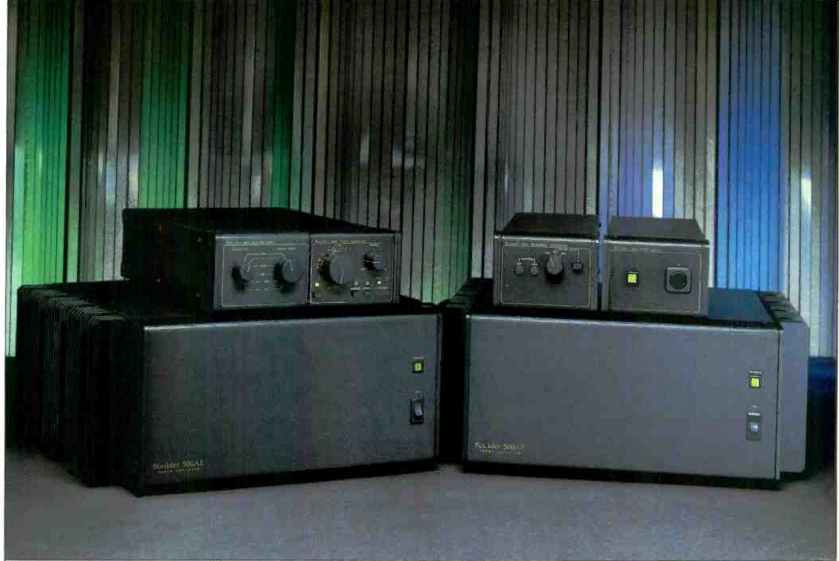
Manufacturer's Specifications:
Frequency Response: 20 Hz to 20 kHz, +0.00, -0.1 dB; 0.015 Hz to 200 kHz, +0,-3 dB.
THD: 0.0015% from 20 Hz to 2 kHz, 0.0025% at 20 kHz, for 2 V out.
Maximum Output Level: 12 V rms.
Maximum Voltage Gain: Phono, 68 dB; line, 11 dB.
Input Impedance: Phono, 47 kilohms (high) or 100 ohms (low); line, 200 kilohms.
Output Impedance: Unbalanced, 50 ohms; balanced, 100 ohms.
Power Requirements: 65 watts, 50/60 Hz; voltage selectable (100/ 120/220/240 V a.c.).
Dimensions: Single-module frame, 5 in. W x 33/4 in. H x 15 1/2 in. D (12.7 cm x 9.5 cm x 39.4 cm); dual module frame, 9 in. W (22.9 cm).
Weight: 23 lbs. (10.5 kg).
Price: $4,795, including modules for power supply, phono preamp, selector switch, and output controller plus one dual-module and two single-module frames; $3,095 without phono preamp module.
Continuous Power: Stereo, 150 watts into 8 ohms, 250 watts into 4 ohms; bridged mono, 500 watts into 8 ohms.
Peak Power: Stereo, 300 watts into 4 ohms; mono, 600 watts into 8 ohms, 1,200 watts into 4 ohms.
THD at Rated Power: 0.0015% from 20 Hz to 2 kHz, 0.005% at 20 kHz.
Frequency Response: 20 Hz to 20 kHz, +0.00,-0.04 dB; 0.015 Hz to 200 kHz, +0,-3 dB. Slew Rate: Stereo, 35 V/uS; mono, 70 V/µS.
Voltage Gain: Stereo, 26 dB (20 x ); mono, 32 dB (40 x ).
Peak Current: 50 amperes.
Damping Factor: 800 at or below 1 kHz, 100 at 20 kHz.
Minimum Input Impedance: Unbalanced, 30 kilohms; balanced, 10 kilohms.
Common-Mode Rejection: 80 dB at 60 Hz, 70 dB at 10 kHz.
Power Requirements: 1,000 watts, 120 V a.c., 60 Hz; export version with selectable voltage and frequency available.
Dimensions: 17 in. W x 5 1/4 in. H x 15 1/2 in. D (43.2 cm x 13.3 cm x 39.4 cm).
Weight: 51 lbs. (23.2 kg).
Price: $2,995; multi-voltage international version, $3,295.
Company Address: 4850 Sterling Dr., Boulder, Colo. 80301, USA.

The Ultimate is Boulder's best foot forward in the preamp department, and the 500AE is their largest, latest amplifier.
The 500AE is basically intended for use as a mono bridged amp. However, it is equally at home as a stereo amp, albeit at lower power, and that is how it was reviewed.
An earlier model, the 500, is said to be the same as the 500AE but with a fancier front panel that included input level controls and various indicators. A smaller model, the 250AE, rounds out Boulder's current line of power amplifiers.
The preamp is modular, consisting of four pieces: The MS01 power supply, MS11 phono preamp with MC capability, MS21 selector switch, and the MS32 output controller with balanced output. A step below the Ultimate in Boulder's hierarchy is the Complete preamp, whose four modules, tied together in a single case, are similar but do not include MC facilities or balanced outputs. If memory serves me correctly, Boulder was one of the first companies to offer preamps in this modular form.
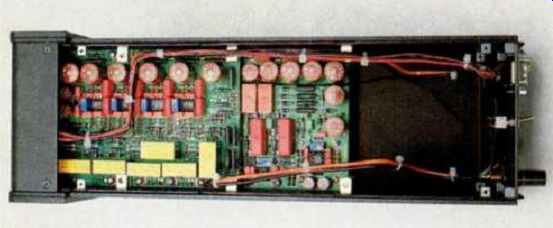
Physically, the Ultimate has its selector switch and output modules tied together in a dual frame, with the phono preamp and power supply separate. This enables the power supply to be placed away from the phono preamp section and permits the phono section to be placed next to or near the turntable.
Actual construction of the modules is fairly straightforward, although I haven't seen very many pieces of hi-fi gear made this way. The chassis of the basic module is composed of two sides, rear and front panels, and top and bottom covers. Small pieces, 1/4 inch square, are riveted to the sides; these pieces have threaded holes to accept the attachment screws which hold the front and rear panels in place. The internal p.c. boards are also attached to the side pieces in this manner. Dress side panels cover the exposed outside of each module. Where two or more modules are tied together as a unit, the adjacent internal sides don't use these dress panels. Finally, each module has top and bottom covers that serve as the means to couple them together. Very nice mechanics indeed.
Internally, the selector switch module is the simplest, having no active circuitry inside. Signal input and output connectors are Tiffany phono jacks, linked by Teflon-insulated wire to a p.c. board at the rear of the module. This board has two rotary switches mounted on it, and long shafts from the front panel couple to the switches. The unit has two' selector switches, one for the signal to be listened to and the other for what is to be fed to a tape recorder or external processing loop. The record selector switch has a couple of extra switch poles that prevent input-to-output feedback of connected tape recorders or signal processors. This works by grounding the feed to tape out of the selected tape input; i.e., if the signal at the tape 1 monitor input is selected as the recording source, the tape 1 record output is grounded.
The phono preamp and output controller modules are of roughly equal internal complexity, both using six (three per channel) of the special discrete operational-amplifier circuits which are the basis for all of Boulder's signal amplifying circuitry. Each of these modules has a motherboard running fore and aft, oriented parallel to the top and bottom surfaces. The op-amp modules plug into the motherboards and are also mechanically fastened to the motherboard at each end of the module. There are lots of high-quality parts in these units. Resistors are all metal-film types, and capacitors are all plastic-encased film types or "audio-grade" electrolytics. The main volume control in the output controller is a Penny and Giles unit--one of the very finest.
The controls on the MS11 phono module's front panel are a pushbutton switch that takes the low-cut filter in and out of the circuit, a three-position frequency selector for the filter, and two screwdriver-adjustable pots for phono gain. A two position toggle switch on the rear panel selects MM or MC gain. On the front panel of the MS32 output controller are rotary volume and balance controls plus pushbutton switches for muting, normal and reverse stereo, mono/stereo, and each channel's output polarity. The rear panel of the output controller has two pairs of Tiffany RCA connectors for unbalanced input and output plus a pair of XLR connectors for balanced output connection.
When the entire Ultimate preamp is connected, a short pair of signal leads with phono connectors couples the output of the selector switch module to the input of the output controller. Similarly. the output of the phono module is connected to the phono input of the selector module. Two additional cables are used to connect the power supply to the phono and output controller modules.
The MS01 power supply feeds about ±25 V d.c. to the active modules. A large, shielded toroidal power transformer of approximately 100 VA is located at the front of the supply module, and the rest of the interior area is occupied by a p.c. board containing the regulator circuitry. Series pass regulating transistors are mounted on two heat-sinks that protrude from the rear of the supply. Four multi-pin connectors on the rear of the supply imply that four Boulder preamp modules can be powered from one supply.
Turning our attention to the 500AE power amplifier, we find a rather solid, businesslike unit of deceptive simplicity.
An uncomplicated front panel sports a power switch and an LED indicator. Looking at the rear panel, one sees a pair of XLR connectors and might ask: Where are the RCA signal input connectors? Boulder, by not including RCA signal connectors, apparently is encouraging people to use balanced-line interconnects from one's preamp. As an increasing number of components--including the Ultimate preamp--now have balanced outputs, this is a reasonable approach. For those who use unbalanced interconnects, all is not lost; Boulder supplies a short adaptor cable with a female RCA connector on one end and the appropriate XLR connector on the other.
Completing the subject of what's on the 500AE's rear panel, we find the usual pair of five-way binding posts for speaker connection. These are arranged with their red (or hot) terminals adjacent to each other, making speaker connections easier in the bridged output mode. Below the speaker connectors is a pushbutton mode switch for selecting stereo or bridged mono operation.
Another pushbutton switch controls whether or not clipping is to be shown on the front-panel power indicator. A word about this indicator: When the amp is first powered up, the indicator is red for a few seconds and then turns green when the amp is ready to operate. When the rear-panel switch is set to show overload, the power-on indicator flashes red whenever this occurs.
A resettable circuit breaker takes the place of the usual replaceable power-line fuse. A two-terminal barrier strip allows the choice of whether or not the chassis is connected to the a.c. third-wire ground.
Looking inside the unit, one's attention is drawn to the way the central fore and aft space is utilized. A subchassis, 6 in. W x 3 in. H x 12 in. D, is mounted in the fore-and-aft direction to the bottom of the amplifier. The four main filter capacitors are mounted side by side under this subchassis, with the terminals of the front two facing to the left and those of the rear two facing to the right (as seen from the front). A large toroidal power transformer is mounted on the top of the subchassis, toward the front of the amp. Mounted on the rear top surface of the subchassis are the main power supply rectifier bridge, a power resistor and relay, and a terminal strip containing several components to control the relay.
The actual amplifier circuitry is contained on four large p.c. boards, two per channel. In each channel, one board is mounted right next to the inside surface of the heat-sinks; the other is mounted parallel to the first and spaced about an inch away with four standoffs. These outer boards have one of the Boulder discrete op-amps mounted perpendicular to their main surfaces. I have not seen very many power amps that have as many parts as the 500AE, although I'm told by the manufacturer that many of these parts are for the sophisticated protection circuitry and for the extra gain stages in this two-stage design.
Physically, the 500AE's metalwork is simple and straightforward. One piece forms the bottom and sides. The sides of this piece are mostly cut out so the p.c. board assembly that is captive to each channel's heat-sinks can pass through when bolted together. Ledges are bent up on the top and rear of this main chassis piece to serve as mounting surfaces for the top cover and rear panel pieces.
The front panel, like all the preamp's front-panel pieces, is formed into a "U," with the bottom of the "U" being the front surface and the sides of the "U" extending back about 2 inches along the bottom and top surfaces of the amplifier.
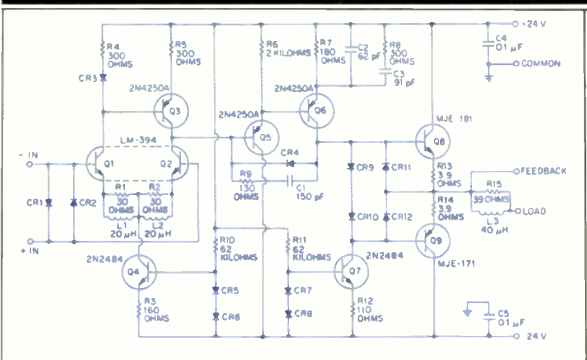
Fig. 1--Deane Jensen's JE-990 op-amp, the basis for Boulder's gain blocks.
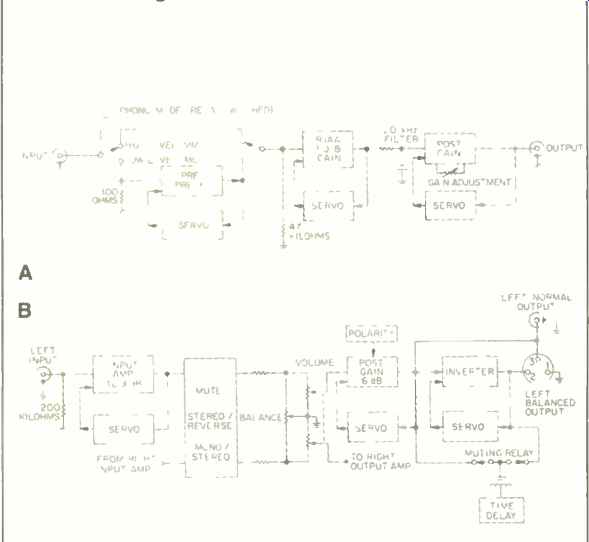
Fig. 2--Block diagrams of the Ultimate preamp's phono module (A) and output
controller module (B).
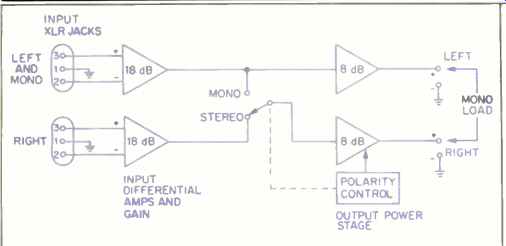
Fig. 3--Block diagram of the 500AE amplifier.
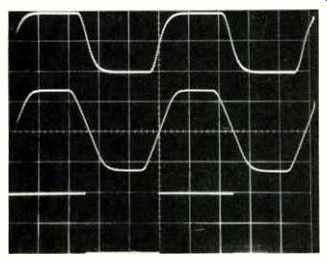
Fig. 4--Response to square waves through Ultimate preamp's output controller
module for (top to bottom): 100 kHz at ±5 V out, 100 kHz at ±12.5V, and 20Hz
at ±5 V. Waveshapes were the same for IHF and instrument loads. (Scales:
Vertical, 5 V/div. for 5-V curves, 10 V/div. for 12.5 V; horizontal, 2 µS/div.
for 100 kHz, 10 mS/div. for 20 Hz.)

Fig. 5--RIAA equalization accuracy for left channel (solid curve) and right
channel (dashed curve).
Circuit Description
One basic circuit is used for most of the signal amplifying blocks in Boulder electronics. Figure 1 shows the original version of this circuit, a general-purpose op-amp designed by the late Deane Jensen of Jensen Transformers to provide low noise, wide bandwidth, low distortion, and stability under many feedback conditions.
Although the topology of this circuit (which Jensen referred to as the JE-990) is nothing special from today's vantage point, and a number of audio preamps and power amps have been built and marketed with similar circuitry, a couple of things are neat and worth mentioning. The use of inductors across the emitter resistors in the first stage is clever. In the audio band, where one wants the emitter resistors to be shorted out for lowest noise, this is accomplished by the low reactance of the inductors. At higher, frequencies, where one wants the emitter resistance in for stability of loop gain, the high reactance of the inductors allows this too. Diode CR4 prevents saturation of 06, thus keeping the circuit's speed up when the amplifier is clipped.
Great American Sound and other companies have used this technique in fully complementary circuits. The use of an output-buffering RL network in the circuit is a good idea that is seldom used outside of power amplifiers. Diodes CR11 and CR12 cause current limiting to take place at about 180 mA of output current. Diodes CR1 and CR2 prevent output latch-up with input signals faster than the response time of the circuit.
The actual circuit modules used as Boulder's gain stages are more complicated than the circuit just described, and they use about twice as many semiconductors. (This allows Boulder to use d.c. coupling between audio stages, thus eliminating coupling capacitors in the signal path.) One can see on examination that ferrite-bead inductors are used for the input-stage emitters, and that many small-signal transistors are thermally coupled together with epoxy and copper clips in pairs and, in one instance, a triplet.
A block diagram of the phono and output controller modules used in the Ultimate preamp is shown in Fig. 2. Starting with the phono module in Fig. 2A, one can see that most of the RIAA equalization is done in the second gain block by frequency-selective negative feedback. The closed-loop gain of this block, at 1 kHz, is on the order of 26 dB, and since the circuit is noninverting, the high-frequency roll-off stops at about 30 kHz by bumping into unity closed-loop gain. Any frequency-selective feedback network connected as a series feedback element in a noninverting op-amp configuration can only reduce gain to unity. The inverting topology can reduce gain below unity. Hence the need for the interstage RC low-pass filter to continue this integration or roll-off beyond 30 kHz and on out to several hundred kilohertz. An extra 20 dB or so of flat gain is provided by the third phono gain block ("Post Gain" in Fig. 2A). By varying the amount of negative feedback in this stage, overall MM gain is variable from about 29 to 47 dB at 1 kHz.
The first block in the diagram of the phono module is a straight pre-preamp, with 20 dB of gain, that is switched in or out as indicated. The actual switching is done by a relay controlled by the rear-panel SPST toggle switch. This gain block is different from all the rest in the Ultimate preamp; the quiescent current in its input transistors is a lot higher, in order to get lower noise levels with the typical low source impedance of MC cartridges. Further, the power-supply voltage to these blocks is reduced to ±8 V d.c. by regulators in the phono module. As can be seen in the block diagram, the input terminating resistor for the MC mode has a value of 100 ohms. Those who want to change this resistor for cartridges of other impedances or to fine-tune the load can only do so by finding the resistor, unsoldering it from the p.c. board, and replacing it with another.
All of the gain blocks in the phono module are direct coupled to each other. Servo circuits around each block keep d.c. offset low enough to permit direct coupling.
In the output controller (Fig. 2B), the first gain block serves the dual functions of presenting a constant and high input impedance to the selected source and of providing the bulk of the necessary gain for the overall line amplifier function. Since there is considerable insertion loss (about 10 dB) in the balance and volume control circuit, the combined gain of the first and second ("Post Gain") blocks must be about 10 dB higher than the desired overall line gain, which comes out to about 8.6 dB. One result of this topology is that the first stage overloads before the output block does, at any volume setting, and does so at about 3.5 V in. The design also allows the volume control to be of unusually low impedance-in this case, 1 kilohm. This prevents a loss of high-frequency bandwidth as a function of volume control setting-or, rather, it puts that loss at frequencies beyond the bandwidth the preamp is designed to handle. A final result of this topology is that two gain blocks are in series instead of the usual single-block line amp, which might offend those of the "fewer devices in the signal path must sound better" school of thought. (They may prefer Boulder's Complete preamplifier, which is of similar design but has only one stage of gain--"for those who want less," says the manufacturer.) The second gain block has a proprietary method of changing the block's overall polarity from noninverting to inverting. Each channel has a switch to do this. If only one such switch is engaged, a red LED warns that the channels are in opposite polarity. If both switches are engaged, the absolute polarity of the input signal is inverted for both channels and a yellow LED indicator comes on.
A time-delay circuit in the output controller opens the normally closed contacts of the output muting relay a few seconds after power turn-on. Interestingly, instead of immediately muting after power turn-off, the circuit waits about the same time as the turn-on delay before muting.
As in the phono module, all of the circuits are d.c. coupled, and servo circuits are used for each gain block to keep d.c. offset low at the output of each block.
A block diagram of the 500AE power amplifier is shown in Fig. 3. The basic philosophy is to use the JE-990 type op amp circuitry in two gain blocks per channel. One is a low-level front-end with a closed-loop gain of about 18 dB. The second block is another operational amplifier of similar topology but with higher power devices (obviously multiple power transistors) in the output stage; this block has a closed-loop gain of about 8 dB. Boulder feels that the use of multiple stages, each optimized for its particular use, yields an overall circuit of superior stability and ultra-low distortion, both static and dynamic. A servo circuit that controls overall d.c. offset maintains the low-frequency 3-dB down point at a very low 0.015 Hz, for outstandingly flat group delay from 20 Hz to 20 kHz.
As can be seen in Fig. 3, the input circuit is fully balanced.
Unbalanced operation is possible by feeding either the positive or negative input, for noninverting and inverting polarity respectively, and ground. Boulder supplies an adaptor for this. It consists of a Tiffany female phono jack connected by a short piece of single-conductor shielded cable to a male XLR plug with gold-plated pins. The cable's shield is tied to pins 1 and 2 of this plug, corresponding to the amp's input ground and negative input, and the cable's hot conductor is tied to pin 3 (the amp's positive input). If one wants unbalanced operation with inverting polarity, the adaptor cable can be rewired so that the shield still goes to pin 1, but pin 1 is strapped to pin 3 and the hot conductor goes to pin 2.
When the mono/stereo switch is set to mono or bridged operation, the right output circuit is connected to the output of the left input circuit. Also, the polarity of the right output circuit is inverted in a manner similar to that used in the line controller's output stage.
A very sophisticated protection circuit in this amplifier creates an analog of the voltage across the output transistors and multiplies it by the current flowing in the load. This accurately assesses power dissipation in the output stage, regardless of the phase of the load current. The measured dissipation is weighted by measured heat-sink temperature and an analog of output-device chip temperature. Thus, a realistic assessment of output-stage capability is available to limit output when it really is needed.
The power-supply setup in this amp is a little different than usual. One transformer winding feeds a full-wave bridge rectifier that is connected in turn to two sets of filter capacitors electrically in parallel but physically oriented toward the channel they supply. This way, the wires from the filter capacitors to their amplifier channels have the same length in each channel. There are four filter capacitors, each 36,000-µF, 75-V types.
On the p.c. boards next to the heat-sinks are eight 470-µF, 100-V capacitors that apparently bypass the supply lines at the site of every pair of same-polarity output transistors. Not only does this keep the local site of each output transistor well bypassed, it also adds about 4,000 µF more capacitance to the power supply.
To prevent excessive a.c. in-rush current when the amp is turned on, a 10-ohm power resistor is placed in series with the primary of the power transformer for several seconds, after which it is shorted out by relay contacts. The relay coil is fed from a half-wave rectifier that rectifies the power transformer's full secondary-winding voltage to produce about 120 V d.c. A 22-µF, 250-V filter capacitor smoothes this supply to keep the relay from chattering. The delay in turning on the relay is the delay in charging the main filter capacitors with the 10-ohm resistor in the primary circuit.
When the secondary is, in effect, "unshorted" by the charging up of the main filter capacitors, the relay's power-supply circuit comes up and turns the relay on. This is a clever idea for generating time delay for such a function, and it has been used in a number of other power amplifiers.

Table IA--Gain (in dB) for Boulder Ultimate preamp, with IHF and instrument
loads, for high (MM) and low (MC) modes at low and high gain settings.
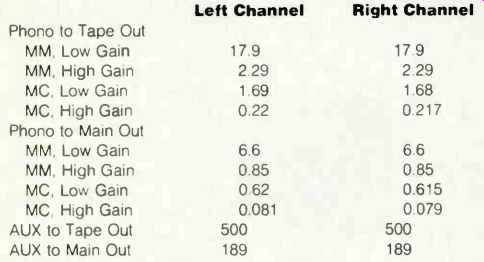
Table IB--IHF sensitivity of Boulder Ultimate preamp (in mV) for high (MM)
and low (MC) modes at low and high gain settings.

Table II--Noise of output controller module (in µV), referred to input,
for 1-kilohm source impedance. The IHF signal-to-noise ratio was 107 dB for
either channel.
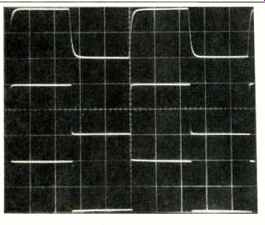
Fig. 6--Response through phono module to pre-equalized square waves for
(top to bottom): 10 kHz, 1 kHz, and 40 Hz. (Scales: Vertical, 1 V/div.;
horizontal, 20 µS/div. for 10 kHz, 200 µS/div. for 1 kHz, and 5 mS/div.
for 40 Hz.)
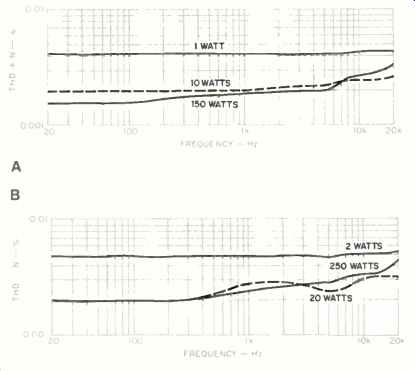
Fig. 7-- Boulder 500AE amplifier's THD + N vs. frequency for 8-ohm loads
(A) and 4-ohms (B), at various power levels.
Preamp Measurements
Looking at the Ultimate preamp first, gain and sensitivity figures for the phono and output controller modules are presented in Table I. The gain values shown are for the controller module's unbalanced main output, and would be 6 dB higher if measured at its differential balanced output.
Concentrating on the output controller, its input resistance was found to be 200 kilohms, and its output resistance was 50 ohms. Rise-and fall-times at an output amplitude of ±5 V were 1 p.S for either my instrument load or the IHF load.
Further, when the volume control was turned down 6 dB from maximum, which usually slows down most preamps, the rise- and fall-times stayed the same. With input amplitude increased so as to drive the output level up to ± 12.5 V, the exponential-edged waveshape that was exhibited at lower amplitudes became straight-sided, a sign that stewing was occurring. Specifically, it looks like a slew rate of about 20 V in 1.6 µS or about 12.5 V/µ S. Oscilloscope traces of square-wave performance that illustrate the preceding are shown in Fig. 4. The top trace is for 100 kHz at ±5 V amplitude, the middle trace for 100 kHz at ± 12.5 V, and the bottom trace for 20 Hz at ±5 V. The traces look the same for instrument or IHF loading. This line section can drive really tough loads! Volume control tracking was checked and found to be within 0.5 dB down to-55 dB, worsening to 2.5 dB at -60 dB and to 3.6 dB at -65 dB, then becoming 0.3 dB with the control fully counterclockwise, at its maximum attenuation of 72 dB. There was excellent correlation between the scale on the front panel and the actual attenuation of the control.
Measuring interchannel crosstalk of the MS32 output controller without the selector switch connected was a surprise.
Instead of the usual crosstalk pattern--very low at low frequencies and increasing as frequency goes up-this device exhibited a more or less constant -53 dB of crosstalk with frequency and was about the same in both directions. When the selector switch was hooked up ahead of the output controller, the behavior was essentially the same. With the output controller's volume set at -20 dB, crosstalk was about -51 dB and flat with frequency. Crosstalk was in phase. This flat crosstalk with frequency is something I haven't seen before; thus far, I have no explanation for the phenomenon.
Output noise for different bandwidths is presented in Table II. The excellent IHF signal-to-noise ratio comes about because of the two-stage topology of this unit. When the volume control is turned down to get unity gain in the line section--i.e., 500 mV out for 500 mV in-there is still 500 mV going into the first, highest gain section of the output controller. Consequently, the S/N of the input stage is terrific, and the overall S/N is degraded only a little by the noise added by the second gain block. In contrast, the usual line stage, a single gain block with about 20 dB of gain following the volume control, will have at least 20 dB less signal present at its input when the volume is turned down to the overall unity-gain point. As a result, its S/N is degraded by at least 20 dB-usually more, as the source impedance that the input stage actually sees is higher than the 1-kilohm line input terminating resistor used in the test.
Total harmonic distortion plus noise for the output controller was outstandingly low. Since it has only 8.6 dB of gain, the maximum 3 V output of my Soundtech distortion analyzer only drove the output controller to about 8 V rms. At this level and driving a 600-ohm load, THD + N was less than 0.01% from 20 Hz to 20 kHz.
A few miscellaneous comments before talking about the measurements of the phono section: The mute function on the output controller lowered the gain by about 21 dB. The a.c. line draw of the Ultimate preamp was about 0.44 ampere. Regulation of the power-supply output voltages held up until the a.c. line voltage was lowered to 90 V. Turning now to the MS11 phono preamp, its measured gain and sensitivity figures are shown in Table I, as mentioned previously. Output impedance at the output of the MS11 itself was about 50 ohms. When going through the MS21 selector switch module, as one would when using the whole Ultimate setup, output resistance for phono at tape out was about 100 ohms, as there are 50-ohm buffering resistors in the selector switch module's tape out paths.
RIAA equalization error is plotted in Fig. 5. The data shown is for the high-level (MM) mode, set for maximum gain. However, the data looked the same for high-level mode with minimum gain and for low-level (MC) mode at either gain setting. Further, the equalization error curve looked essentially the same with instrument or IHF loading.
It's nice to know that the phono equalization is going to be the same, regardless of mode, gain, or loading of the output. This is decidedly not the case with a number of other phono preamps! Related to the frequency response error of the phono equalization is the accuracy of reproducing pre-equalized square waves. As can be seen in Fig. 6, waveform shape and amplitude were essentially the same with instrument or IHF loading. The equalization accuracy of the MS11 is outstanding.
When increasing the drive level to see how the circuit overloads, I found that it symmetrically compressed the high frequencies, starting at an output level of about twice that shown in Fig. 6. When the front-panel gain adjustment was turned down to minimum, the output level attainable for the same degree of compression reduced accordingly; this simply means the overload is taking place in the first gain block, where the bulk of the gain and equalization occurs. Phono overload as a function of frequency is depicted in Table III. Data shown is for high (MM) level and maximum gain. This circuit behaves ideally, in that its output overload point is absolutely constant with frequency; the input acceptance is a perfect mirror of the RIAA curve. Results with instrument or IHF loading were about the same. Rather than show all the data for the three other mode and gain combinations in Table Ill, the well-behaved properties of this unit permit me to mention here just the 1-kHz input overload levels for these other mode and gain conditions. (The input voltages for output overload at other frequencies track the inverse RIAA curve virtually perfectly.) With the gain reduced to minimum in the high-level mode, input acceptance at 1 kHz was a whopping 535 mV. With the unit in the low-level mode, the input acceptance for high and low gains was 6.5 and 69 mV, respectively. What is not obvious is that the input acceptance is entirely related to the relative gain of the various mode and gain combinations.
Harmonic distortion plus noise with a 600-ohm load in the high-level, high-gain mode was less than 0.01% at 10 V output from 20 Hz to 20 kHz. Impressive.
Referred input noise for the phono module is shown in Table IV for a variety of conditions. The difference in the MM and MC noise figures for the gain blocks' two modes of operation is very apparent in the measurements. (Recall that the phono equalizer first-stage gain block uses the JE-990 op-amp in the normal form, whereas the MC block uses a modified form of the JE-990 for lower noise with low source impedances.) All noise levels are satisfactorily low, although not state-of-the-art low.
The phono module's interchannel crosstalk versus frequency was checked for different modes, gain settings, and source impedances. The lowest crosstalk numbers were obtained in the MM high-gain mode, with a 0-ohm terminating resistor for the undriven measured channel. Crosstalk was asymmetrical, being lower in the right-to-left direction.
With a more realistic 1-kilohm terminating resistance, crosstalk in the worse direction (left to right) was better than 90 dB from 20 to 300 Hz, decreasing to 80 dB at 1 kHz, to -63 dB at 5 kHz, and to-52.5 dB at 20 kHz. Using the dummy IHF MM source, crosstalk maxed out at-35 dB at 10 kHz in the left-to-right direction. Reducing gain in the high-level mode equalized the difference between crosstalk directions, and it reduced crosstalk in either direction by about 8 dB from :he figures quoted above. In the low-level mode, crosstalk was again better in the right-to-left direction, and with a 100-ohm terminating resistor, in general it was about the same as in the high-level mode. All crosstalk in the phono module was in phase.
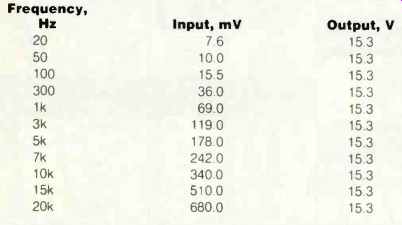
Table III--Phono overload vs. frequency for high (MM) mode at high gain setting.
Left and right channels were virtually identical, and there was negligible
difference between results with instrument and IHF loads. For phono
overload in low (MC) mode and at other settings, see text.
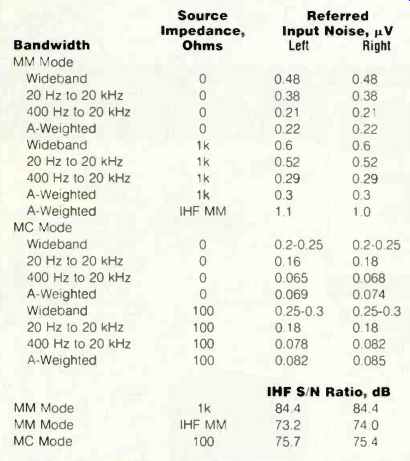
Table IV--Noise of phono section, referred to input, and IHF S/N ratios,
vs. mode and source impedance. The high gain setting was used; in low gain
settings, noise was about 10% higher in both MM and MC modes.

Fig. 8--SMPTE IM and THD + N vs. power for 8and 4-ohm loads.
THD + N is for 1-kHz test signal.
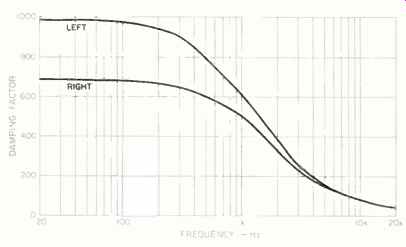
Fig. 9--Damping factor vs. frequency.
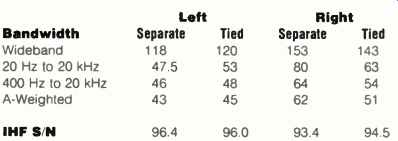
Table V-- Boulder 500AE output noise (in µV), and IHF signal-to-noise ratio
(in dB), with inputs terminated by 1 kilohm. Data is shown for signal grounds
separated and tied together; see text.
Amp Measurements
The 500AE power amplifier was run at one-third rated power, or 50 watts per channel into 8-ohm loads, for one hour. As usual, the heat-sinks got very hot, but otherwise the hour passed without mishap.
I used two Boulder phono-to-XLR adaptors to connect to the signal inputs, and voltage gain in the unbalanced mode was 20.4 x, or 26.2 dB, for both channels. (This adaptor is wired to feed the unbalanced hot signal to pin 3, which is the noninverting input.) Sensitivity for 1 watt output was 140 mV. Voltage gain in the balanced mode was the same as in the unbalanced mode, provided the same magnitude of input signal was applied between the positive and negative inputs.
Total harmonic distortion plus noise is shown in Fig. 7 as a function of power output, frequency, and load. The right channel was slightly higher in distortion, and its results are plotted in the Figure. One thing quickly apparent in this data is the very low amount of distortion this amplifier exhibits; I don't recall ever testing a power amp that measured this low in distortion. Also of note is that the distortion does not rise very much in the high frequencies compared to its levels in the low and middle frequencies. To measure 0.005% or less at full power at 20 kHz into 4 ohms is not my everyday experience here at BHK Labs.
Figure 8 shows THD + N at 1 kHz and SMPTE-IM distortion as functions of power output and load. When this amp is driven into clipping, the positive half-cycle clips first; symmetrical clipping is technically more desirable.
Output noise, with inputs terminated by 1 kilohm, is shown in Table V for various bandwidths and with and without the input signal grounds tied together. Sometimes it makes a difference. In this case, when the grounds were tied together, which is what would happen when the 500AE is connected to a preamp, the output noise of the two channels became more nearly the same. The differences lie in the amount of line hum and its harmonics in each channel's output rather than in differences in random noise.
Interchannel crosstalk, like output noise, was found to be dependent on whether or not the input grounds were tied together. Crosstalk in this amp, as in most others, is also load-dependent; when the load is disconnected, crosstalk reduces dramatically. With the input grounds tied and the outputs loaded by 8 ohms, the worst (right-to-left) direction was better than-90 dB at frequencies up to 300 Hz, decreasing to-88 dB at 1 kHz,-76 dB at 5 kHz, and staying at about 75 dB up to 50 kHz. This property of the crosstalk leveling off above a certain frequency is unusual in my experience.
Damping factor as a function of frequency is shown in Fig. 9 for both channels of the 500AE. Damping factor at low frequencies is very high but is reduced at high frequencies, as is usual in amp designs that use an output RL buffering network.
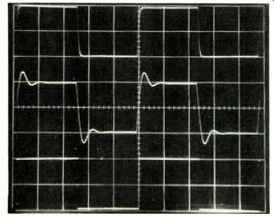
Fig. 10--Amplifier square wave response. Top trace is 10 kHz with 8-ohm
load; middle trace is 10 kHz with 2-µF capacitance across the 8-ohm load;
bottom trace is 40 Hz into 8 ohms. (Scales: Vertical, 5 V/div.; horizontal,
20 µS/div. for 10 kHz, 5 mS/div. for 40 Hz.)
Small-signal frequency response was flat from 10 Hz to above 20 kHz and was down 1.3 and 1.6 dB with 8- and 4-ohm loads at 100 KHz. Rise-and fall-times at ±5 V were 1.8 µS with 8-ohm loads. Behavior was similar up to about ± 20 or ±25 V, above which slewing started to set in, first for the negative-going direction and then for the positive-going direction. Approximate slew rates were then -30 V/µS and +40 V/µS. Oscilloscope traces of square-wave responses can be seen in Fig. 10. The top trace is for 10 kHz into 8 ohms; in the middle trace, 2µF has been paralleled across the 8 ohms, and the bottom trace is for 40 Hz into 8 ohms.
Common-mode rejection was checked for both channels.
The method used was to drive the amp to a reference 10 V output in the unbalanced input mode. A special connection to the XLR input jacks was then made, tying pins 2 and 3 together for signal high and with pin 1 signal low as usual.
This drives both the positive and negative inputs with the same signal. If the common-mode rejection of the input gain block were perfect, no output from the amplifier would result. Output was measured as a function of frequency, referenced to the aforementioned 10 V. In the left channel, which was slightly the worse, common-mode rejection was better than 90 dB from 20 to 100 Hz, worsening to 83 dB at 1 kHz, 69 dB at 5 kHz, and 57 dB at 20 kHz.
Finally, dynamic and clipping headroom were assessed.
Results for dynamic headroom were 1 dB at 189 watts into 8 ohms and 1.6 dB at 364 watts into 4 ohms. Clipping head room was 0.54 dB at 170 watts into 8 ohms and 1.1 dB at 320 watts into 4 ohms. Peak current into a 1-ohm load, with one channel driven and using the same tone-burst signal as in the tests for dynamic headroom, yielded an impressive ±48 amperes.
Use and Listening Tests
Ancillary equipment used in evaluating the Boulder 500AE amp and Ultimate preamp included an Oracle turntable fitted with a Well Tempered arm and Koetsu Black Goldline cartridge (replaced later in the tests with a Spectral Audio MCR Select), a Nakamichi 250 cassette deck, a Technics 1500 open-reel recorder, a California Audio Labs Tempest CD player, a Vendetta Research SCP-2A pre preamp, and a Cook-King tube phono preamp. Power amplifiers on hand for comparison included a pair of 100-watt mono tube units from EAR and a Sonographe SA120. Listening was done through Siefert Research Magnum III speakers.
I have to be honest and state from the outset that I had a predisposition that these Boulder components might not sound as good as other leading solid-state gear because of all the devices in their signal paths--i.e., those multiple gain blocks in every major functional block.
Listening evaluations were made in a number of sessions spread out over a number of weeks in quite a lot of different ways. First, the phono module alone was listened to through my Cook-King tube phono preamp's selector switch and stepped output attenuators-my usual reference signal path. The Vendetta Research pre-preamp was also listened to in this way. Under these conditions, the Boulder MS11 phono module was set for MC gain to obtain enough listening level. Although I felt the Vendetta Research produced the better sound in terms of resolution, space, air, and detail, the MS11 gave a very good account of itself, producing a softer sound that was quite listenable and enjoyable.
Next, I listened to the combination of the selector switch and output controller, using CDs and other high-level sources. The sound, primarily using familiar CDs, was a bit brighter than my reference setup's. This is most likely because of the Boulder's low output impedance driving the long interconnect cables I use, compared to the higher driving impedance in the reference path. Other preamp line sections have driven this line without necessarily sounding brighter, though. I then fed the output from my CD player into my reference system's attenuator in two alternate ways, first through Boulder's MS21 selector and MS32 output controller set at unity gain, and then directly into another of my attenuator's high-level inputs. This allowed me to compare the sound of the inserted devices with the direct feed from the source. With my reference controller's attenuators at the settings I normally use when listening to CDs and using my standard cables between this reference controller and the amps, the reference system with the Boulders sounded much more like the reference system alone. However, I still preferred my normal path, not going through the MS21/MS32. I used EAR 519 tube amps in this test.
Now we come to the subject of the 500AE power amplifier. Boulder had also sent one of their Model 500 amps, which I had for a considerable while before the 500AE and Ultimate units arrived. I had listened a number of times to the 500 and found it somewhat disappointing. Upon the arrival of the 500AE, I, set about to decide if the two amps sounded the same. Much to my delight, the 500AE sounded noticeably more open and alive.
I then started listening to the entire Boulder equipment chain with LP and CD sources. I listened for several days to this gear and found myself saying that it sounded pretty good-not as good as my reference, but quite listenable and musical. I was able to get into the music. I installed my new Spectral Audio MCR Select moving-coil cartridge, got it roughly tweaked in, began to listen, and experienced quite a shock of realization. The sound of my system using this new cartridge through the Boulder gear was so superior in terms of openness, space, air, and resolution that I haven't gotten around to listening to my other reference equipment yet! I preferred the sound of the system using the phono module in MM mode even though the S/N ratio was obviously better in MC mode. I briefly tried a pair of Boulder's CB-35 balanced interconnects, which are 35 feet long and allow balanced operation between the preamp and power amp inputs. Sonically, I didn't think this sounded any better and actually preferred unbalanced operation with the interconnect cable I had been using.
No particular operational glitches were found in using the gear, with one exception: The low-cut filter in the phono module would produce a mild surge in the woofers if it was engaged when system gain was up. The Penny and Giles volume control was a constant pleasure to turn and use. I enjoyed experiencing the Boulder gear and would recommend prospective purchasers give it a serious listen.
--Bascom H. King
(adapted from Audio magazine, Feb. 1990)
Also see:
Bryston 4B NRB Amplifier (Aug. 1992)
= = = =